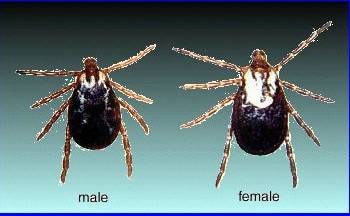Outdoor safety topic ticks
There are 11 species of tick in Alberta, however the usual tick encountered on Rocky Mountain hikes near Calgary is the Rocky Mountain wood tick, Dermacentor Andersoni, photo below. It is not one of the species usually associated with transmission of Lyme disease (yet!), see the Canadian Lyme Disease Foundation website and Lyme Disease Association of Alberta for more information. Alberta Health Services has acknowledged that the risk of lyme disease contraction in Alberta is increasing and has a tick surveillance program. This surveillance program shows that ticks carrying the disease have been found in Alberta but none reported, as of 2014, in the usual hiking areas.See the following reprinted article for info on dealing with ticks.

Source:
Of the 800 or so kinds of ticks in the world about 650 are hard and the rest
soft. It's the hard cover tick hikers encounter.
Adult ticks range in size from about 0.4 cm to 1.4 cm long. They are oval shaped and appear to have reddish leathery bodies with eight legs. Of course, spiders also have eight legs so you shouldn't be surprised to learn that ticks are also of the arachnid class.
Ticks hunt by stealthily clinging to grass and shrubs along paths frequented by potential hosts. When a host passes by, the tick climbs on.
On the ground, ticks can also hunt down a host from as far away as 25 feet by homing in on its carbon dioxide emissions. Once on a host, the tick's goal is to attach itself to the skin and have a blood feast. A feeding tick can increase 20 to 50 fold in size.
The mere bite of a tick can deliver disease to the host. However, it is the disease organisms inhabiting the tick's stomach that are the source of the many serious diseases it transmits. Some of these diseases include encephalitis, typhus, Lyme disease, tick paralysis, and Rocky Mountain Spotted Fever. It is for this reason that ticks should be removed as soon as possible and every precaution taken to ensure the tick does not regurgitate the contents of its stomach while attached to a host.
Detaching a tick from its host can be accomplished by waiting for it to become fully engorged and then disengaging itself. Or, by physically removing it.
The recommended procedure for this is to gently but firmly grasp the head of the tick with tweezers as close to the skin as possible and apply a steady backward force until the tick releases its hold. Any tick parts remaining in the wound must be removed to prevent infection. If the head is buried beneath the skin and cannot be seized with tweezers, you will require medical attention to remove the tick. Always treat the wound with a germicide or an antibiotic cream. If your tick is from an area where tick disease is known to occur, it is advisable to keep the tick and give it to the attending physician for examination. In Alberta ticks seldom carry serious diseases.
Methods such as using petroleum jelly, oil, tape, lighted matches or alcohol to induce the tick to pull out are not effective and may prompt the tick to empty its stomach contents into the wound.
One technique that may prove effective is to cool the area near the tick with snow or ice. In addition to cooling off the tick's external environment, this intervention would also slow the blood flow in the area. It is possible that the combination of these factors would encourage the tick to detach in order to seek more optimal conditions.
Prevention is the best strategy when dealing with ticks. Common sense says cover up - wear long pants tucked into socks and long sleeved shirts that fit snugly at the neck and wrists. Don a hat. Spray clothing with an effective insect repellent (DEET) or insecticide.
After emerging from tick habitat, immediately check for ticks on humans and animals because it takes ticks many hours to attach to a host and it is easier to remove them before they do so.
Tick season in Alberta is at its peak during the spring. By the end of June ticks are seldom encountered and hikers should be relatively safe.